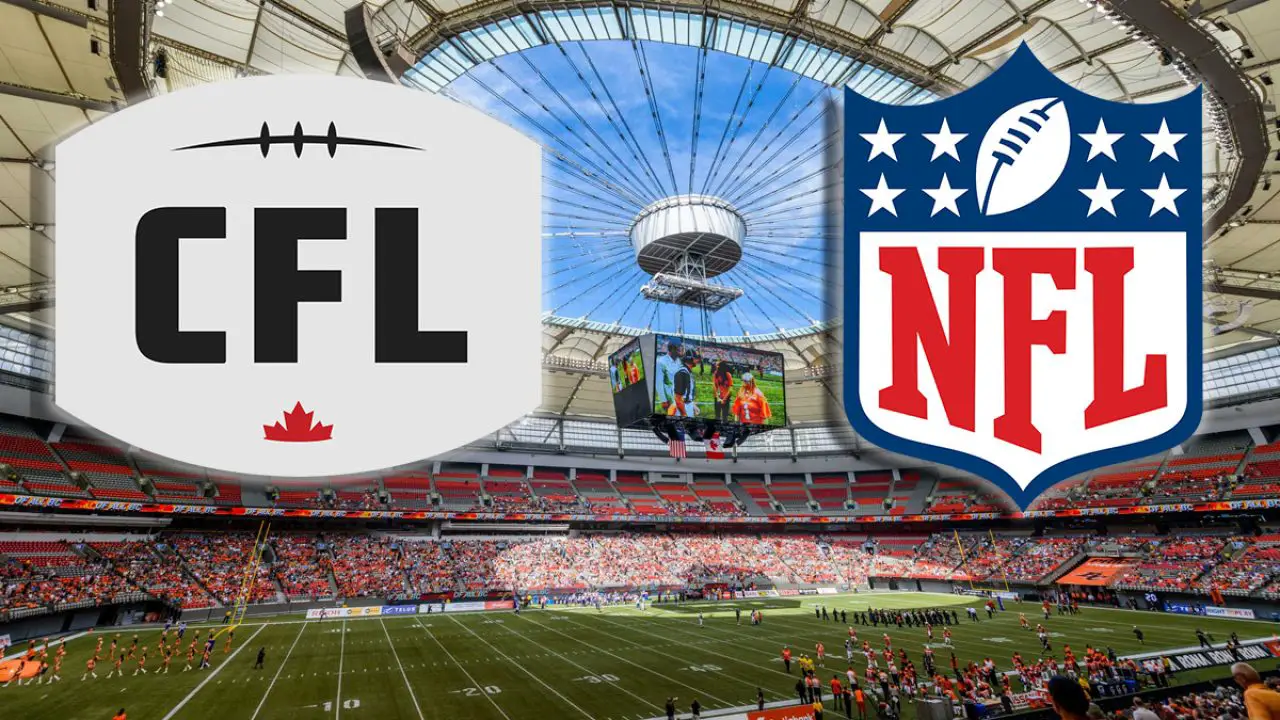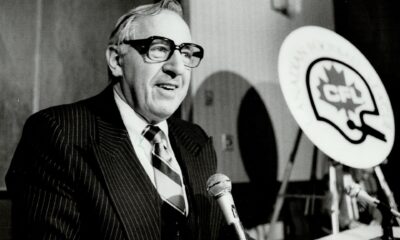
The NFL and CFL are arguable the two most prominent football leagues in the world. Here are the rule differences between the NFL rules and CFL rules:
- Football Field Dimensions
An NFL football field is a rectangle that is 120 yards long, or 360 feet. This means that each end zone is 10 yards and the neutral playing field is 100 yards long. The field is also slightly over 53 yards wide, or 160 feet.
A CFL football field is also a rectangle. However, a CFL field is 150 yards long, or 450 feet. The end zones are each 20 yards long, and the neutral playing field is 110 yards long. The width of the field is 65 yards long, or 195 feet.
- Number of Players On the Field
This brings up the next difference in the rules between the CFL and the NFL, which is that the CFL has 12 players on the field at one time while the NFL has 11. Due to the CFL playing on a larger field, they felt that it was alright for each team to put one more man on the field. This allows the offense to have one more eligible receiver, which makes the passing game that much more appealing.
- Number of Downs
In the NFL, a possession includes four downs. Each down allows the offense to attempt to gain a first down. Often times, when the offense is on their own side of the field,
the offense will punt the ball to the opposing team in order to flip field position. If the offense is on the opponents side of the field, then they will be more likely to go for it on fourth down or kick a field goal. By going for it on fourth down, the offense risks the chance of turning the ball over to the opponent if they fail to gain a first down.
In the CFL, there is only 3 downs in a possession. The same strategy applies in the CFL. However, they get one less down. If the offense fails to gain 10 yards after the first two downs, they will be forced to either punt the ball or kick a field goal. If they decide to go for it on third down, they risk the chance of failing to get the first down and turning the ball over.
- Overtime Rules
The next major rule difference is the overtime rules. The NFL overtime rules are similar to the beginning of a normal game. There is a coin toss where the away team gets to decide heads, or tails. Then the winner of the coin toss gets to select if they would like the ball, or if they would like to kick. Then the overtime begins like a typical game. However, in overtime if the first team to possess the ball scores a touchdown then the game is over. Otherwise, the next team to score is the eventual winner.
The CFL overtime rules are very similar to college football overtime rules. Each team will have a possession that starts on the 35-yard line. Once they have either scored, or turned the ball over, the opposing team gets a chance to score from the 35-yard line. Touchdowns in these overtime periods must be followed by a two-point conversion. If it is tied after the first overtime, then there will be up to two more overtime periods that follow.
In both leagues if the overtime periods result in the score being tied, the game will be ruled a tie. However, if it is a playoff game, the overtime rules will proceed until there is an eventual winner.
- Scoring
The two leagues share similar rules for touchdowns and extra points. Both leagues score a touchdown as six points. Each league gives the scoring team the opportunity to kick an extra point, or go for two. Safeties are also worth two points in both leagues.
The major difference in scoring between the two leagues is when it comes to kicking a field goal. Both leagues score a field goal as three points. However, the goal posts for field goals are placed at a different part of the field in each league. The NFL places their goal posts at the back of the end zone, this adds 10 yards to each kick since the end zone is 10 yards in length. The CFL places their goal posts at the frond of the end zone. This means that whatever yard line the ball is kicked from is the length of the field goal.
In addition to this slight difference the CFL has a one-point rule. This rule states that a missed field goal, or punt, that is not returned out of the end zone results in the kicking team receiving a point. Also, if a missed field goal, or punt, is kicked out of the back of the end zone, the kicking team receives a point.
- Kickoffs
Kickoffs are slightly different in the CFL and NFL. The players on the kickoff team in the NFL must stand on the 35-yard line and are not allowed a running start, except for the kicker. In the CFL, all players must be at least 10 yards away from the 35-yard line, and are allowed to take a running start.
In the NFL, if two teams simultaneously recover a kick it is up to the referee’s discretion to rule who receive possession of the ball. In the CFL, if two teams simultaneously recover a kick then the play is voided and there must be a re-kick.
The last rule difference is that in the NFL players can fair catch a kickoff inside the 25-yard line and their team will receive the ball at the 25-yard line. In the CFL there are no fair catches.
- Punting
The difference in punting between the two leagues is about the return. In the NFL, if the punting team covers the kick well and is close to the returner, the returner can call for a fair catch. In the CFL, there are no fair catch calls. Instead, the punting team must leave a 5 yard buffer zone between them and the returner when he is attempting to catch the punt.
- Challenges
This is a miniscule rule difference, but it could make a huge change to a game. In the NFL, a coach is granted two challenges. If the coach successfully uses both challenges, then the coach is rewarded with a third challenge to be used at any point during the rest of the game. If the coach is unsuccessful their team is charged a timeout. In the CFL, each coach is given one challenge. Regardless of the outcome of the challenge that is their sole challenge of the game. An unsuccessful challenge in the CFL also costs their team a timeout.
- Play Clock and Timeouts
The NFL play clock is 40 seconds. This means that the offense must snap the ball within 40 seconds of the ball being marked at the end of the previous play. In the CFL, the play clock is only 20 seconds. This puts more pressure on the offense, and it also increases the pace of play. This makes the action more frequent, which may help fans enjoy the game.
Timeouts are different in the NFL and CFL as well. In the NFL, each team gets three timeouts per half. They do not carry over from one half to another, so any timeouts not used are lost. In the CFL, two timeouts are allotted to each team a game. Each team may only use one of their timeouts during the last three minutes of the second half. However, in the last three minutes of the half, the clock stops after each play.
- Schedule
The NFL recently extended their schedule to a 17-game season. This means that each team will play 17 games in 18 weeks, and then those who make the playoffs will continue to play in the playoffs. In the CFL, there are 18 games played in 21 weeks. This means that the CFL teams receive 3 bye weeks, while the NFL teams only get 1 bye week. Similar to the NFL, the CFL teams that make the playoffs after the regular season will continue to play those games until they lose, or the season is over.
- Other Slight Differences
There are two other slight rule differences between the NFL rules and CFL rules. The first rule difference is that there is a 1 yard neutral zone between the O-line and D-line in the CFL. In the NFL there is a neutral zone, but it is not 1 yard it is the length of the football. The other rule difference between the two leagues is that in the NFL you must have two feet in bounds to secure a catch. In the CFL, you only need one foot in bounds to secure a catch.
Full coverage of the 2022 season on CFL News Hub.


5 Comments
Leave a Reply
Cancel reply
Leave a Reply
Big Announcement: CFL Unveils Free Live Streaming Platforms
Get Alerts & Stay Connected
CFL iPhone AppCFL Android App



















David Tress
May 22, 2021 at 12:02 pm
You can’t play four down football on the larger CFL field because the defenses would run out of gas.
Jamie
October 15, 2021 at 3:04 pm
You misunderstand some NFL rules. For instance, when discussing NFL overtime rules you state: “…in overtime if the first team to possess the ball scores a touchdown then the game is over. Otherwise, the next team to score is the eventual winner.” This is simply not the case. The first team to possess the ball may well kick a field goal, in which case the other team would need a touchdown to win. A field goal by the other team would simply keep the game going.
Also, you state that, “in the NFL players can fair catch a kickoff inside the 25-yard line and their team will receive the ball at the 25-yard line. In the CFL there are no fair catches.” Again, I believe this is incorrect. As far as I know, this is simply a rule in NCAA (college) football and NOT the NFL. In the NFL, a fair catch must be caught in the endzone to bring the ball out to the 25 yard line.
Jacqueline
November 28, 2021 at 11:01 pm
I think CFL overtime rules are silly. My high-school team lost in overtime because a ball kicked as a field goal (missed) bounced out of the end zone scored a point and won the championship game
John
December 12, 2021 at 11:44 pm
“in the NFL players can fair catch a kickoff inside the 25-yard line and their team will receive the ball at the 25-yard line” – This is a college rule, not in the NFL.
Joe Blow
November 20, 2022 at 8:54 pm
They forgot to mention that the Offense in the CFL can have multiple men in motion and they can be moving forward toward the line of scrimmage. In the NFL, the offense can only have one man in motion and must be moving laterally or backwards.